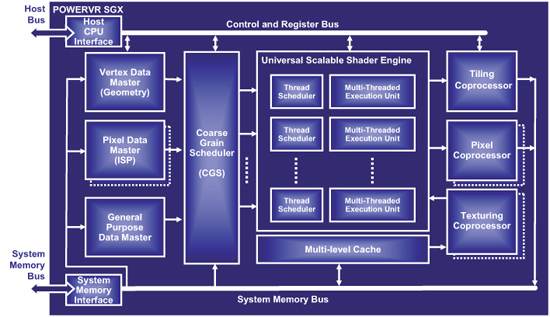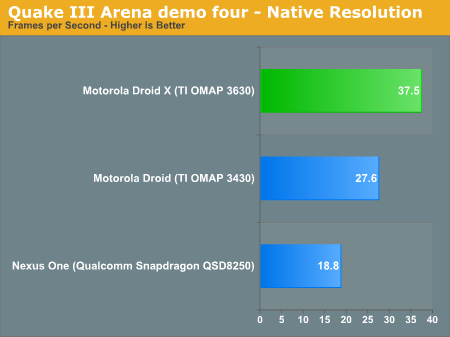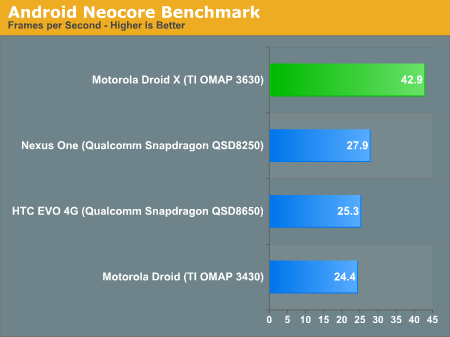Motorola Droid X: Thoroughly Reviewed
by Brian Klug on July 20, 2010 4:27 PM EST- Posted in
- Smartphones
- Motorola Droid X
- OMAP
- Mobile
The OMAP GPU - Powered by Imagination Technologies
TI continues to license its GPUs from Imagination Technologies. Rather than move to the PowerVR SGX 535 used by Apple and Intel, TI stuck with the same PowerVR SGX 530 core used in the OMAP 3430. The difference between the SGX 530 and 535 is as follows.
ImgTec refers to the execution hardware in its Series 5 GPUs as a Universal Scalable Shader Engine (USSE). Each USSE pipe can execute a 2-wide vector or up to a 4-way SIMD scalar op in a single clock. Both the SGX 530 and 535 have two USSE pipes from what I can tell.

The SGX 535 used in Apple’s A4 and Intel’s Atom Z600 series apparently have a second texturing unit and DirectX 9L support.
We’d expect that 3D apps on smartphones are more compute bound these days so it’s difficult to say how much you lose by going with the SGX 530 vs. 535. Until we get a Moorestown dev kit running Android we won’t be able to shed much light on that.
While the OMAP 3430 ran the GPU core at ~110MHz, the 3630 ramps it up to 200MHz. We’re seeing a lot of convergence around this 200MHz mark at 45nm. Intel runs the SGX 535 in Moorestown (Atom Z600 series) at 200MHz as well and I believe that’s what Apple uses in the A4 as well.
The 80% increase in GPU clock speed should result in significant real world GPU performance improvements. Just as with the CPU, there are no significant architectural changes to the GPU - it just runs faster.
The memory controller is still a 32-bit LPDDR1 interface, but can now run at up to 200MHz (the 3430 was limited to 166MHz). Should a customer choose to go for 200MHz LPDDR1 you’d get a 20% increase in memory bandwidth which will come in handy with the faster GPU in 3D apps for sure.
The GPU Performance Showdown: Snapdragon vs. OMAP 3630
When Brian first started cranking on the Droid X review he wanted to put the Qualcomm Adreno 200 vs. PowerVR SGX debate to rest. We had always reported that Qualcomm’s Snapdragon GPU was slower than the PowerVR SGX used in Apple’s A4 and TI’s OMAP 3, but we didn’t have a good idea of how much slower. Until now that is.
Armed with the Google Nexus One (Snapdragon QSD8250), Motorola Droid (OMAP 3430) and Motorola Droid X (OMAP 3630) all running Android 2.x (the N1 was running 2.2) we polished off one of the most popular GPU benchmarks of our time: Quake III Arena.
The kwaak3 project ported Q3A from a Nokia N900 version to Android. With a bit of elbow grease and getting around the lack of touchscreen keyboard support, we got the benchmark running. All scores were generated at default graphics quality settings and at native resolution, which unfortunately means the Droid X has around 7% more pixels to render than the other Android devices.

Even with the handicap, the 200MHz PowerVR SGX 530 core manages double the frame rate of the Adreno 200 in the Nexus One’s Snapdragon. Even the 110MHz SGX 530 is faster.
Here’s another interesting tidbit - we’re actually CPU bound on all of these platforms running demo four in Q3A:

Droid X (OMAP 3630) CPU utilization while running Quake III Arena
Intel is talking about greater than 100 fps frame rates with Atom Z600, meaning that the advantage is strictly on the CPU side. This also tells us that the PowerVR SGX 530 may even be a good fit for next year’s Cortex A9 based SoCs, even though TI has already committed to using the SGX 540 in its OMAP 4 line.
Neocore is another popular GPU benchmark, although this one is written for Qualcomm’s Adreno 200. The OpenGL ES 1.1 benchmark is mostly a GPU test but also stresses the platform as a whole. Running on our OMAP 3 based phones we see an average of 50% CPU utilization during the test.

The Droid X (OMAP 3630) CPU utilization while running Neocore
Interestingly enough, running the same test on a Snapdragon platform shows higher CPU utilization:

The Nexus One (Snapdragon) CPU utilization while running Neocore
The benchmark could be very well optimized for Qualcomm’s Scorpion core resulting in better CPU utilization compared to a Cortex A8.

The Adreno 200 in the Nexus One and EVO 4G outperforms the PowerVR SGX in the original Droid by 4 - 14%. This isn’t a surprise given the Qualcomm branding on the benchmark. The 45nm SGX 530 running at 200MHz puts all question to rest, the OMAP 3630 is 53% faster than Snapdragon.
The comparison here is obviously more than just GPU to GPU. We’re dealing with different CPU cores (ARM Cortex A8 vs. Qualcomm Scorpion), different memory controllers, different caches, and different drivers. Just as we’ve seen in the desktop GPU race, driver and benchmark optimizations have a lot to do with 3D performance results. I put more faith in the Quake 3 results, however those too came from a port optimized for PowerVR’s SGX.










89 Comments
View All Comments
TareX - Thursday, July 22, 2010 - link
Why are all the Samsung Galaxy S phones missing from your charts and comparisons? I wanted to see how Hummingbird compared and how the Super AMOLED fared against their Droid X counterparts...strikeback03 - Tuesday, July 27, 2010 - link
Maybe because the first US version launched a day before the review went up, and they weren't sent a review sample.enealDC - Thursday, July 22, 2010 - link
Great job!Juniper Research - Friday, July 23, 2010 - link
Very interesting article... we have this week published a new report on smartphones and a free whitepaper is available to download here... http://www.juniperresearch.com/reports/next_genera...John Levett
Marketing Executive at Juniper Research
Homefries - Saturday, July 24, 2010 - link
First off, great review Brian.However, while you did a very thorough comparison of the Droid X to other Android devices, you barely mentioned the real competitor the Droid X has to stand up against: the iPhone 4.
Readers want to know if the Droid X is the best phone on the market - the whole market - not just the market subset dedicated to Android devices.
Like the majority of the tech media, your review furthers the notion readers belong exclusively to either the iOS camp or the Andriod camp. This is simply not true. Informed readers, like the ones that peruse Anandtech, want to buy one smartphone, regardless of any marketing slants, that is the best.
Your review of the Droid X should have helped us answer the question, "Should I buy the Droid X or the iPhone 4?" But, it did not.
strikeback03 - Tuesday, July 27, 2010 - link
Well, I think the conclusion in the iPhone article and some earlier Android articles applies, there is no "best" for everyone. Some people love Apple and the Apple way of life, some people won't touch it. As the iPhone is currently limited to AT&T, that is going to deter a lot of people. How large a pocket/bag you plan on carrying the phone in might make size differences more important to some than others. So while I am not one of the readers calling for no subjective opinions (it is interesting that FroYo feels significantly faster/different) I think it is still up to each buyer to decide what is most important to them.Electrofreak - Saturday, July 24, 2010 - link
Brian and Anand, are you sure you're using the correct information regarding the SoC in the Droid X? I believe it is a OMAP 3640, not a 3630, as the maximum recommended clock speed of the 3630 is described in numerous places across the net as being 720 MHz, while the max clock speed of the 3640 is described as 1 GHz. In addition, the max recommended clock speed of the 3430 in the Droid was 600 MHz, not 800.The information I cite above is widely available across the web... if you've got inside information the rest of us don't have, by all means let us know. But as someone who has written articles of my own on ARM SoCs and follows ARM industry news closely, I suspect that your data may not be 100% correct.
Regardless, I do have to thank you for writing some of the most informative hardware articles on the net. I appreciate it!
Electrofreak - Saturday, July 24, 2010 - link
...and I just found this: http://e2e.ti.com/blogs_/b/mobile_momentum/archive...So, per TI's blog it is the 3630... now we just need an explanation of the other info on the web that describes the 3630 as maxing out at 720 MHz.
Brian Klug - Monday, July 26, 2010 - link
Yeah, TI's documentation is a bit outdated. Anand tackled the SoC part, but the 3630 is indeed a 1 GHz part, it isn't the 3640 guaranteed. There was a lot of confusion online about it, but Anand got the official word. ;)I agree, back when I did my other OMAP 3 piece it was 720 MHz.
-Brian
Electrofreak - Saturday, July 24, 2010 - link
Looking forward to that Hummingbird review Brian. I hope you're able to dig up some info that I wasn't able to when I wrote my article (http://alienbabeltech.com/main/?p=17125) back in April.